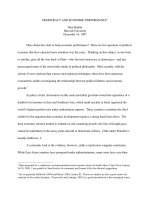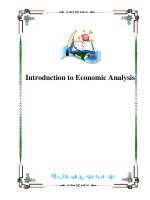Morocco economic profile
Bạn đang xem bản rút gọn của tài liệu. Xem và tải ngay bản đầy đủ của tài liệu tại đây (2.29 MB, 32 trang )
Profile of Morocco's Economy
● Morocco's Finances
○ Morocco's Budget Deficit
○ Government Bond Yield Curve
○ Inflation
○ Domestic and External National Debt
● Balance of Payments
○ As a Percent of GDP
○ Components
○ Impacting Factors
● Gross Domestic Product
○ Growth
○ Per Capita
○ Evolution
○ Investment and Consumption
● Imports and Exports
○ Morocco's Trade
○ Percent of GDP
Portfolio of Morocco's
Economy Continued
● Foreign Investment and Remittances
○ FDI Net Flow
○ Morocco's Net Foreign Reserves
○ Remittances
● Morocco's Infrastructure
○ Infrastructure Projects
● Morocco's Banking Sector
○ Non-Performing Loans
○ Proportion of Banknotes in Money Supply
○ Banking Penetration
○ Penetration of Capital Markets
● Morocco's Middle Class
○ Growing Middle Class
○ Internal Consumption Driving Demand
○ Government Policies
Morocco's Finances
Morocco's Budget Deficit
●
●
The global financial crisis has a
negative drag on Morocco's budge
●
Before the crisis, even with govt
subsidies, the budget showed a
slight surplus
●
Privatization efforts have benfited
the Moroccan budget
Despite an increasing budget
deficit, Morocco's inflation rate
has remained at low rates
Government Bond Yield Curve
●
Yields on government bonds of all lengths have decreased by nearly
50% between Dec 2010 and June 2012
●
Lowering bond yields point to a more stable economic environment in
Morocco
Inflation
●
Between 1990-1994 inflation was at an all high in 1991 of 8.0%, the average
inflation for this time period was 6%
●
Starting 1996-97 inflation dramatically decreased, averaging 2% between
1996 and 2012
●
Inflation is predicted to rise again in 2012
Domestic and External National
Debt
●
Domestic debt makes up the overwhelming majority of Morocco's debt
●
External debt has decreased from 2003 to a low of 9.9% of GDP in 2008
when the financial crisis drove it back into the 12% range for 2010 and 2011
●
Total debt, as a percent of GDP, decreased during the early 2000's but is up
against due to the global financial crisis
Morocco’s Balance of Payments
Balance of Payments as a
Percentage of GDP
●
Balance of Payments: a snapshot of all monetary transactions between a
country and the rest of the world
●
Current Account Balance: the sum of the balance of trade, factor income which is profit on foreign investments- and cash transfers and is one of two
measures that go into the balance of payments
●
Positive in the beginning of the decade, current accounts went heavily
negative in 2008 due to the global financial crisis
Balance of Payments Components
as a Percentage of GDP
●
Moroccan exports have remained level from 2000-2011
●
Moroccan imports have increased significantly between 2006-2011
●
Morocco’s capital accounts, one of the two parts of the balance of
payments, has been a small proportion of GDP
●
Remittances continue to play an important role in Morocco's economy
Factors Impacting Balance of
Payments
●
A high exchange rate makes
exports more expensive and and
hurts the trade balance
●
Today the Moroccan dirham is at a
5 year high against the Euro
●
The dirham is also at a 5 year low
against the dollar
●
Morocco's foreign reserves
have remained stable at US
$19-25 billion for the last 7
years
●
Foreign reserves have been
over 20% of GDP since 2001
Gross Domestic Product
GDP Growth:
●
Morocco’s real GDP in the 1990's fluctuated wildly mostly due to
agricultural variations
●
Non-agricultural GDP has grown steadily and at an increasing rate since
1994
GDP per Capita
●
Morocco’s GDP per capita grew at 2.3% in the 1990's
●
2000-2004 saw a 10.8% increase in per capita GDP and 2004-2009 saw
another 10.9% increase
GDP Evolution
2000
2005
2009
●
Morocco’s GDP growth has been spread regionally
●
Urban areas of Casablanca and Rabat have experienced the most growth
○ Nearly doubling over 9 years
Investment & Consumption
Contribution
●
Domestic consumption makes up the majority of GDP, levels have
remained at 75%
●
The majority of GDP growth is driven by investments in Morocco
Imports and Exports
Morocco's Trade
●
Europe remains Morocco's largest trading
partner both for imports and exports
●
France is the number one trading partner
●
Between 2007-2010 trade with China
increased 11% and China is now the third
largest source of Moroccan imports
Imports and Exports as Percent of
GDP
●
Morocco's exports have grown at
the same rate as GDP
●
As a percentage of GDP, exports
have remained remained stable
from the 1990's to present
●
This trend is expected to continue
through 2013
●
Morocco's imports have risen faster
than GDP growth
●
The 2008 global financial crisis
caused a temporary drop in
Moroccan imports to levels seen in
the early 2000's
Foreign Investment and Remittances
FDI Net Inflow
●
FDI Net inflow in Morocco peaked in 2007, before the global financial crisis
●
Morocco's FDI net inflows have been declining since 2007 both in real terms
and as a percentage of GDP
Remittances
Source: World Bank
●
Remittances to Morocco in 2011 were slightly above ($US) 7 billion which is
an all-time high
●
Remittances have been steadily rising since 2000 when they totaled only
($US) 2 billion
Morocco's Infrastructure
Infrastructure Projects
Tanger-Mediterranean Port
●
Morocco's highway network has increased
from 1096 kilometers to 1800 between 2010
and 2012
●
Morocco has invested ($US) 4.4 billion in the
highway network since 1989 and will invest
another 1.7 billion through 2015
●
Morocco's Tanger-Med port on
the Straits of Gibraltar has
modern infrastructure capable of
handling hydrocarbons, misc.
trade, and passengers
●
($US) 1.8 billion has been
invested in Tanger
●
It is estimated that Tanger-Med
will be one of the top 15 busiest
ports in the world
Morocco's Banking Sector









